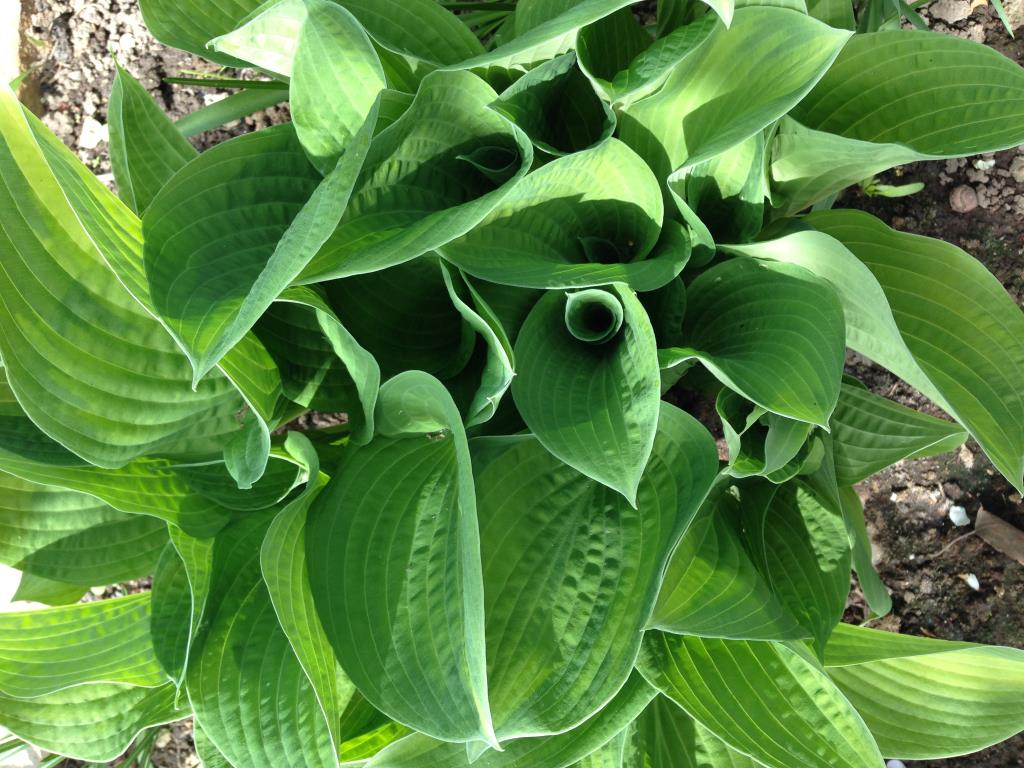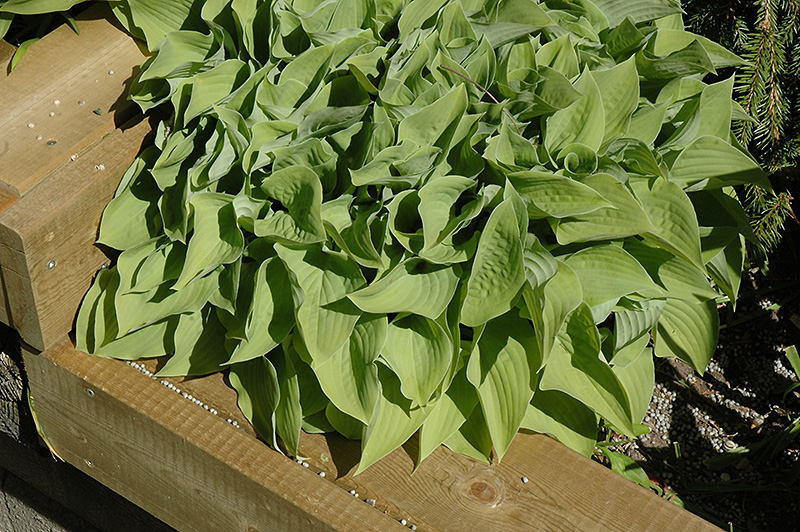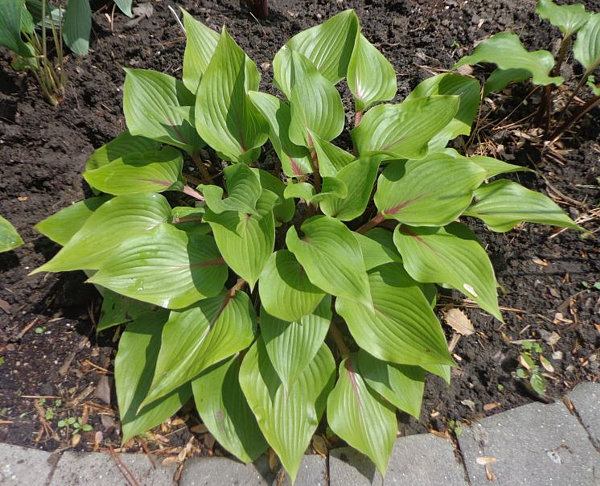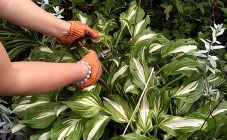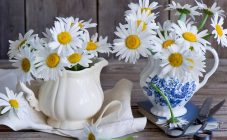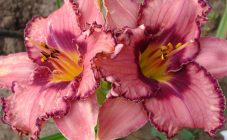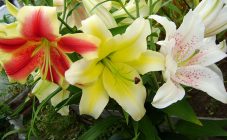Content:
Hosta is a perennial plant, belongs to the asparagus family, their homeland is the Far East and Japan. In nature, there are about 40 species of wild-growing crop species, and with the help of selection, much more has been bred. The unifying feature is the structure of the bush in the form of a rosette with a short rhizome and large leaves. Flowers are located on high peduncles, there are white, lilac, purple, yellow.
The hosta plant, all its types, is valued not so much for the beauty of flowers, but for interestingly colored leaves. And the most valuable quality of this flower is its shade tolerance.
Characteristics of host species
Hosta is a long-liver of herbaceous footprints, in one place it can grow up to 20 years. Moreover, it is good both during flowering and without flowers. To understand how diverse and original its types are, it is worth talking about each of them.
Khosta plantain
The leaves of this species are large, ribbed, colored light green, and resemble plantain in shape. Large white flowers bloom in August, have a pleasant aroma, and look like lilies.
Hosta wavy
It got its name from the leaves curved in a spiral. The color is green at the edge and white in the middle. Blossoms with purple flowers. It throws out peduncles 0.8 m high.
Hosta fortune
The leaves are wide, heart-shaped, green with light yellow tips. A characteristic feature of the species is a waxy coating. The bush is compact, the petioles are short, and the peduncle is up to 0.5 m. The flowers are purple, funnel-shaped.
Hosta lanceolate
The second name is narrow-leaved. A beautiful bush in the shape of a hemisphere with a lot of pointed glossy green leaves. Purple flowers rise by half a meter, begins to bloom in August and continues until the very frost.
Hosta white-bordered
The shape of the bush is a rosette with a diameter of 0.6-0.7 m and a height of about 20 cm, the leaves are wide, pointed. The color is green with a white border. It blooms with lilac-purple flowers on a stem 30 cm high. Prefers to grow in partial shade. The bush is very decorative even without flowers.
Hosta yellow
Yellow species differ in the size of the bush, in the shape of the leaves (lanceolate, wavy, smooth). The most famous varieties:
- Sum and Substance is a giant bush up to 180 cm in diameter, leaves are glossy, heart-shaped, bright yellow.
- Variety Zolotistaya forms a dense yellow-green bush up to 150 cm in diameter.
- Variety Dancing Queen with wavy leaves, which by the end of summer change color from green to light yellow.
- The new variety Holland Flame has bright golden leaves on red stalks.
Hosta green
These varieties include:
- Light green with dark green edging;
- The host is bloated;
- Trill with green lanceolate leaves;
- Dark green;
- Invincible, Mahito;
- Housewife with round leaves and a rose-shaped bush;
- Rock Happy and others.
Hosta red
Among the red-leaved varieties can be distinguished:
- Tsvetnaya Slava - with light green leaves in the middle and red along the edge;
- Red leaves - dark red in color;
- Red Hosta is very decorative, pale green, almost white with bright red veins and dark green edging.
Cyan (blue) host
There are several varieties. They are covered with a waxy coating and have an unusual bluish tint. The bell-shaped flowers are purple or white, the inflorescences rise above the bush. It blooms from early summer until the onset of cold weather.
Hosta with white border
Miniature and dwarf hosts
Those varieties whose height does not exceed 10 cm are called dwarf, if this parameter is in the range from 10 to 15 cm - this is a mini-host. As single plants, such babies are unlikely to draw attention to themselves, but the compositions created with their help look elegant and original.
There are green:
- Round Leaves - Abiqua Miniature, Collector's Choice, Floradora, Lakeside Neat Petite
- Lanceolate - Tiny Tears, Hosta venusta;
- Stiletto has long, wavy green leaves with white edging. The leaf is shaped like a dagger.
Yellow-leaved:
- Variety Gold Drop has heart-shaped leaves measuring only 5 cm. This hosta is lutescent - changing color. By the end of summer, it becomes yellow-golden.
- Wavy Mini - Lemon Lime, Chartreuse Waves, Feather Boa, Royalty, Yellow Eyes, Yellow Waves;
Mini-hosts with white center of the leaf:
- Delia,
- Green with Envy,
- Little Caesar,
- Sitting Pretty;
- Medusa with highly twisted lanceolate white leaves with emerald edging.
There are also dwarf and mini varieties with blue, gray and marble leaves of various shapes.
Hosts for sunny spots
Most of them prefer to grow in the shade, this quality is often appreciated by gardeners. But it has been observed that exposure to the sun sometimes beneficially changes the appearance of this plant. With the help of selection, varieties were bred, the color of which becomes the most advantageous in sunny areas. Typically, these are green varieties with thick leaves.
Yellow-leaved varieties behave differently. In some, in the sun, the foliage acquires a beautiful golden hue, while others, on the contrary, turn green, losing the originality of the color.
Light-loving varieties:
- Sun Power is a bush with a height of 0.6 - 0.7 m, wavy leaves, yellowish-green in spring, and bright yellow in summer. Blooms in July-August, lavender flowers.
- Fire Maiden is a very decorative shrub with gray-green leaves with a white border, wavy along the edge. The flowers are quite large, purple.
- Christmas Candy - large leaves with a white center and a green border. The flowers are pale purple or white.
- Blue Ivory - only this variety, which has a blue tint of leaves, is able to grow in a sunny place. Ribbed gray-blue leaves are beautifully bordered with a cream border. In extreme heat, the color still fades, and the border becomes white. Blooms in June with light purple bells.
Khosta curly
Smiley mouse
Refers to mini-varieties. Height 15 - 20 cm, wavy leaves with a yellow-cream border.
Variegated
This is the name for various host varieties that have unevenly colored leaves.
Free jazz
The variety was bred in 2013, the color of the leaves is a yellow center and a green border. The leaves are wide, the petioles are short. Belongs to the group of averages.
Teaspoon
Hosta with yellow flowers
- The Miracle Lemoni cultivar has yellow flowers that are rare for the host, similar in shape to small lilies. Peduncles are not tall, in inflorescences from eight flowers.
- Cameo hosts.Cameos combine varieties with white leaf edging. These include: Hosta Hope, Sparkler, Seducer, buckshaw Blue, Hosta Cutie, Grand Price and others.
- Plantaginea Venus. It stands out for its large white double flowers that open in the evening and have a magnificent aroma. The height of the bush is 55 cm, the leaves are green, glossy.
Hosta spotted
- The Sugar Lager variety - dark green glossy leaves are dotted with large irregular white spots. It looks very decorative.
- Hosta is tricolor. Varieties have been bred whose leaves have simultaneously green, yellow and blue shades, sometimes separated by a white stripe: Hosta June, Whirlwid, Captain Adventure, Striptease, Spectacular tricolor.
Giant hosts (host tree)
Such hosts can grow up to 1.5 m in height and occupy an area of more than 2 square meters. m. These giants also differ in color and leaf shape, like their miniature counterparts.
- Aisi Halo with gray-green foliage with white border;
- Blue mammoth with blue-gray leaves;
- Jay Cascade - looks like a fountain of narrow green corrugated leaves;
- Empress Wu is the largest of all giants. The leaves are huge, in the spring - with a waxy coating, corrugated.
The most beautiful, unusual, rare, expensive hosts
New collectible varieties with prices from 1000 rubles. and more:
- Variety First glance (Frist blucg) with red-green leaves, price 3000 r;
- A galloping lizard with wavy speckled leaves;
- Khosta Almost (Almost) - ribbed light green leaves;
- The prophecy of the lake is fulfilled - yellow-green pimpled leaves of a rounded shape;
In addition, there are many beautiful varieties for up to 1,000 rubles:
- Hosta Let's twist again (Let Twisn Again) - 900 r;
- Hosta O Lord (Goodness Grasios) - 850 RUB;
- Hosta Victor - 650 RUB
Features of planting and care in the open field for unusual hosts
The host is considered a plant for the lazy, and yet the basic rules of planting and care in the open field should be followed.
- the time for disembarkation is early spring or October, the place must be chosen taking into account the variety;
- planting material should be cleaned of damage and rot and treated with a special preparation that stimulates growth and root formation;
- it is better to fertilize the soil in autumn with organic matter, and if this was not done, then complex fertilizer is applied to the holes;
- the distance between the holes should be equal to the height of the future bush, the holes should be wide enough to fit the straightened roots;
- then cover the measles with earth, compact and water.
Valuable varieties need to be looked after especially carefully, not allowing the soil to dry out. Feed only with special complexes according to the instructions attached to them.
Main crop pests and control measures
The main enemies of the hosts are slugs. You can get rid of it by scattering the Thunderstorm or Mitelaldehyde bait. You can also lay out pieces of plywood around and collect parasites that have climbed under them.
From an attack of caterpillars, you need to spray the leaves with an insecticide.
In order for a beautiful and strong host to grow, the species for planting must be selected taking into account the characteristics of the site, its illumination. With careful care, it will delight the eye for years.
* Prices are approximate, actual for autumn 2018

